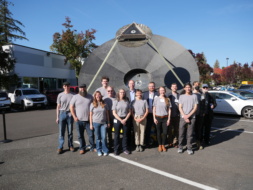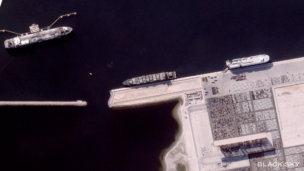When Planet Labs went public in 2021, the company touted a commercial Earth observation market on the verge of an inflection point.
Driven by tailwinds in agriculture, finance, ESG, and energy markets, Planet forecast that its revenue derived from the commercial sector would grow from 54% of total revenue in FY21 to 68% by FY26.
Instead, the opposite has happened.
EO pioneer’s commercial revenue has declined both as a percentage of total revenue and on an absolute basis. In Planet’s Q2 earnings report released earlier this month, the company said that only 23% of its revenue came from commercial end markets.
The decline in commercial revenue represents a reversion to the broader industry demand profile, which EO experts peg at roughly 50% US government, 25% allied government, and 25% commercial.
The now government-dominant business is a far cry from Planet’s pre-IPO prospectus, as highlighted in the chart below, which projected the jump in commercial EO demand would occur across a swath of industries.
Where did Planet’s commercial revenue go?
Planet has pointed to general macro headwinds, the ebb and flow of business budgets, and weakness in the agriculture sector as the primary reasons for the declining percentage of commercial revenue.
Agriculture: “Quarter over quarter, we definitely saw a downtick in the commercial sector, driven primarily by some of the larger agricultural contracts where we’ve seen our customers facing their own challenges,” said Planet CFO Ashley Johnson on the Q1 2025 earnings call.
For example, some of Planet’s customers were providing digital agriculture apps largely for free as loss leader products. But with the agriculture sector facing general headwinds, this model became unsustainable, and Planet has had to reduce its scope of work with these customers to maintain the relationship.
ESG: In addition to agriculture, Planet touted the emergence of a robust ESG market during the pre-IPO dog and pony shows. Management believed that businesses would need satellite data to track ESG metrics. However, ESG hype faded, and the market hasn’t materialized as forecasted.
The softening commercial EO market has weighed on Planet’s overall revenue growth, with the company showing only small gains in sales over the past three quarters.
The company expects the sales trend to continue in Q3.
The challenges in the agriculture and ESG markets are emblematic of broader commercial adoption obstacles that include pricing, finding use cases, and competition from open-source data.
Pricing:
- EO data is still expensive, and images are often not presented as actionable analytics.
- Companies don’t care that an image came from space; they want data at a price point that makes sense.
“While the prices of commercial satellite imagery, including Planet, have been decreasing in the past few years, they have not reduced enough to warrant large-scale adoption in the commercial sector,” said Aravind Ravichandran, founder of EO advisory firm TerraWatch Space.
Open data:
- If businesses do not need time-sensitive or highly curated data, they may decide to use free and open-sourced EO alternatives like ESA’s Sentinel satellites or NASA Landsat satellites.
- For example, a farmer may determine that high-level data on crop health from Landsat is sufficient enough to inform their crop rotation decision.
To help address these obstacles, Planet brought in tech product guru Kevin Weil as President and invested heavily in building and buying analytics offerings (think actionable data, not just raw images) over the past few years.
After the company unveiled the Planet Insights Platform earlier this year, Kevin Weil left to become the chief product officer at OpenAI.
Shifting strategies
Now, with the analytics-based solutions in place, the company said it is shifting investments in the commercial sector toward a lower-cost-to-acquire strategy while refocusing on the government sector.
The effort is beginning to improve profitability after years of operating deeply in the red.
Planet’s adjusted EBITDA has improved for five straight quarters, and the company has set its sights on getting the number positive by Q4.
Long live government budgets: Last month, Planet won a NATO APSS program contract to supply EO imaging for tracking adversary infrastructure, movements, and threats.
- The newly established APSS program will contribute over $1B over five years for space-based data.
- The deal highlights the growing need for intelligence gathering, particularly during this period of heightened security.
Earlier this week, Planet also secured a multi-year contract with the German Space Agency for daily imaging and archival data.
“Planet, like most of the EO sector, will focus on short-term wins in the defense and intelligence sector while continuing to invest slowly in their commercial applications where there is undoubtedly a lot of potential,” said Ravichandran.




